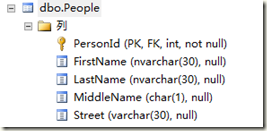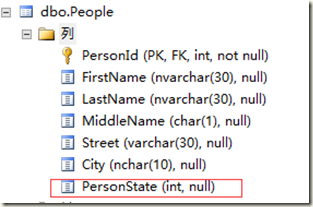1.复杂类型(complex types)
复杂类型是定义Entity列集合的类,没有主键,不直接映射表。在类中定义复杂类型时,必须为非集合类型。
看实例,我们在前面几篇学习中的实例中添加Address类
public class Address { public string Street { get; set; } public string City { get; set; } public string State { get; set; } } public class AddressMap : ComplexTypeConfiguration<Address> { public AddressMap() { Property(p => p.Street) .HasColumnName("Street"); Property(p => p.City) .HasColumnName("City"); Ignore(p => p.State);//忽略State对表列的映射,在数据库表中不会有此列 } }
在People类中添加属性。注意一点的是添加属性后必须在构造函数中初始化,否则会异常
public Address Address { get; set; }//必须为集合属性
public Person() { Phones = new HashSet<Phone>(); CompanyList = new HashSet<Company>(); Address = new Address();//必须初始化 }
记得在Context中注册AddressMap
modelBuilder.Configurations.Add(new AddressMap());
那么我们在数据中怎么对应?我们需要在People表中增加Street列和City列,结构如下
2.使用枚举类型
在程序中使用枚举类型来对数据库中数字进行表示,能够让程序有更好的可读性。我们定义一个PersonState枚举类型
public enum PersonState { Active, IsActive, Unknow }
在前面程序的People类中添加代码:
public class Person {public PersonState PersonState { get; set
; }//新增
}
还有一步要做的就是要在前面People表中增加PersonState字段,定义为int类型。
下面我们就可以利用枚举类型了,看示例:
var query = context.People.Where(p => p.PersonState == PersonState.Active); foreach(var person in query) { Console.WriteLine(person.LastName); }

